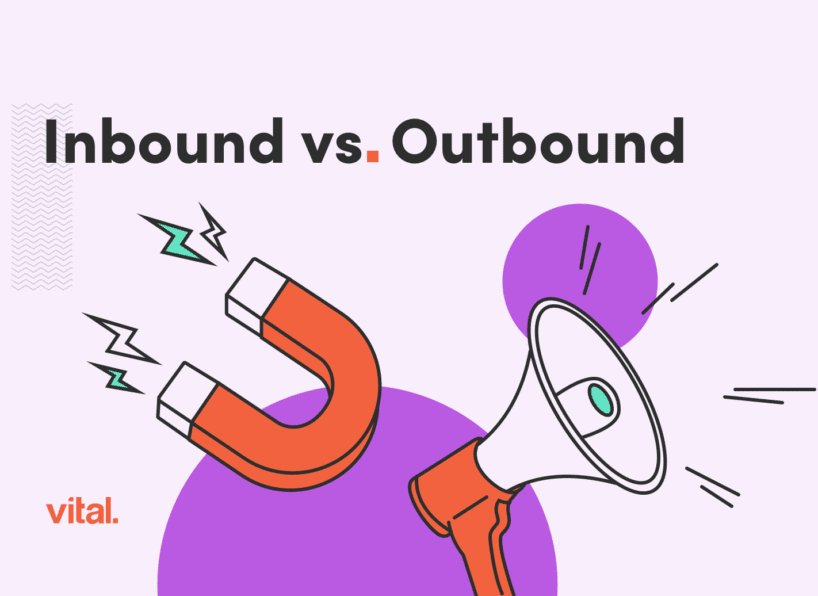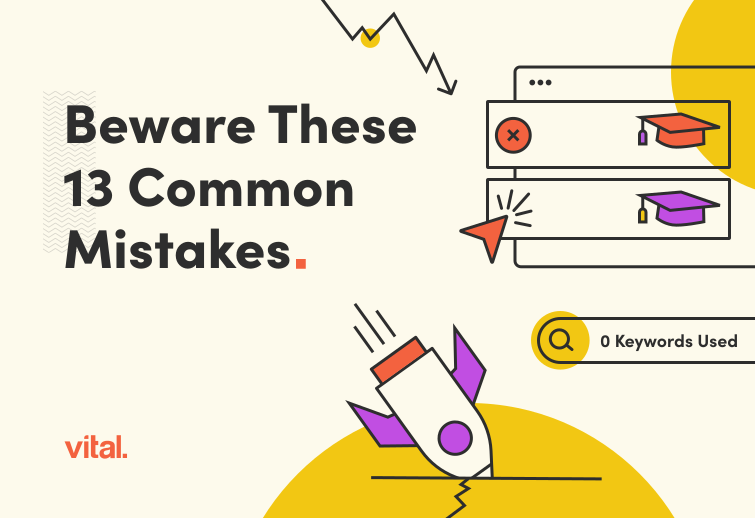Vital’s First-Hand Experience
As CEO of a digital marketing agency and inbound marketing convert, I’m always talking about the differences between inbound marketing vs. outbound marketing. Specifically, I’m answering questions like, “Why is inbound marketing better than outbound marketing?”
In case you can’t tell from the header graphic, I’m more partial to the complexities of inbound marketing than the simplicity of outbound marketing. But seriously, I’m pretty sure people keep asking this question because the same answer seems to be given no matter whose blog you read. It’s as if someone (HubSpot and Pardot) wrote a canned answer and it’s being regurgitated without real-life experiences and insights into the actual evolution of inbound marketing.
The canned answer usually goes something like this:
Why try to buy customers with traditional “outbound marketing” when consumers aren’t even paying attention?
- More than 235 million people are on the national Do Not Call Registry.
- 29% of TV commercials are not actually seen by viewers.
- You have a better chance of surviving an airplane accident than having someone convert on a banner ad.
Forget about trying to reach a prospect under 40 with outbound marketing. Inbound marketing is different. Inbound marketing works by earning someone’s attention, rather than buying it.
It’s a good enough answer with compelling supporting statistics, but there’s more to inbound marketing than this. In this post, I’m going to give you my insights. But I’m not just going to harp on how outbound is reaching increasingly diminished audiences and how inbound is more engaging and more accessible — although both statements are very true.
I’m going to speak from experiences that are real. And in the spirit of full disclosure: Vital is a HubSpot Partner Agency, so I could simply repurpose HubSpot’s experiences and playbook like most partner agencies. But we also consider ourselves a Moz shop, with a Moz Pro account, and we’re a WordPress design and development agency and Yoast SEO plug-in (not the HubSpot COS), which means we have some independent experiences and additional tools that frame our perspective.
No experience is more relevant to that perspective than our own inbound transformation. Over the past three years, we went from referring to ourselves as a creative agency (web design, SEO, and branding) to wholeheartedly embracing the moniker “inbound marketing agency.”
But we weren’t sold inbound — we experienced it. We are our own best inbound marketing case study. In an industry many say is difficult to scale, Vital has experienced 300% growth in revenue and 300% growth in employees, all of which is solely attributed to our inbound and content marketing strategies.
First, let’s define inbound marketing vs. outbound marketing, keeping in mind two aspects of marketing strategies: distribution and messaging.
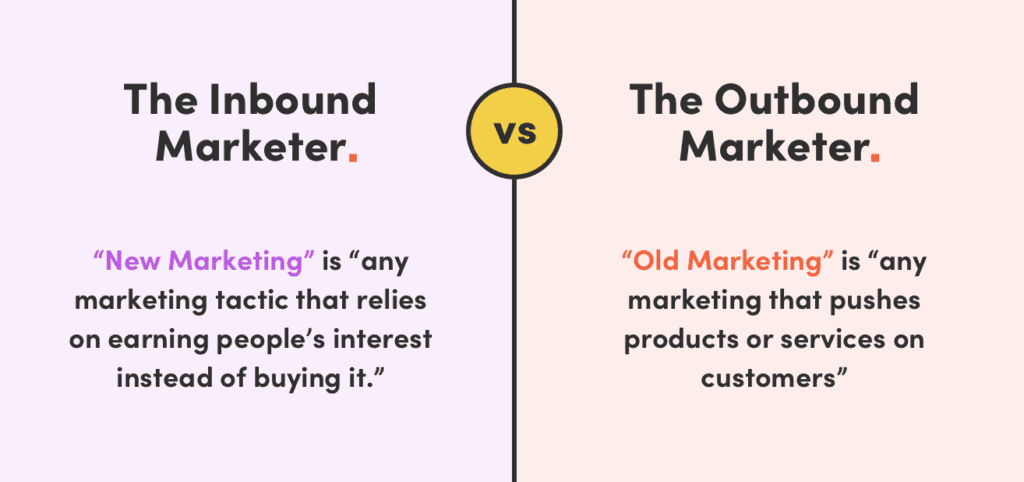
What is Inbound Marketing?
Even if HubSpot didn’t coin the term “inbound marketing,” they have certainly spent a lot of time and money branding it as their own.
Here’s how they define inbound marketing:
“Inbound marketing focuses on creating quality content that pulls people toward your company and product, where they naturally want to be. By aligning the content you publish with your customer’s interests, you naturally attract inbound traffic that you can then convert, close, and delight over time.”
It took Vital a while to embrace the term “inbound” to describe what we were doing with our clients. In the beginning, we referred to it as “SEO” and “content marketing.” And although we weren’t a HubSpot partner agency at the time, we were reading their content.
We knew a term was needed for the paradigm shift we were seeing in online marketing. SEO had fundamentally changed and digital marketing was becoming increasingly more disparate from traditional marketing. Digital distribution made analysis highly measurable and results-oriented, showing that inbound marketing was exponentially more successful than outbound marketing — when done correctly.
It’s not just that traditional distribution was so different from digital distribution; the message was changing, too. And the more we were learning about the message, the better the results we were getting. The terms “digital marketing” or “traditional marketing” only spoke to the distribution aspect of the message, and “inbound marketing” included the new message itself.
This new message was educational, involved thought leadership, and was transparent and engaging. So, in the absence of anything better, we drank a little bit of the HubSpot Kool-Aid and gave in — today we call it inbound marketing, too. But there’s more to inbound marketing than the statistics on the dwindling audience of outbound and the engaged and accessible audience of inbound.
What is Outbound Marketing?
Outbound marketing is “inherently obfuscated, duplicitous, and full of shit.”
Also known as traditional marketing, outbound marketing includes tactics like:
- Radio
- TV
- Newspapers
- Magazines
- Direct-mail
- Billboards
- Event sponsorships
A traditional outbound strategy can even be found in such digital distribution forms as email blasts, banner ads, PPC, and spam. But the defining qualities of outbound marketing are in the messaging.
Outbound is a world of jargon where the loudest and most obnoxious marketers are rewarded. Back in the day, clever was rewarded. But due to the escalating costs and increased competition to reach dwindling audiences, marketers have had to dumb things down to the lowest common denominator to maximize their conversions.
So we are left with advertisements that use fluorescent pink, bold print, BIG discounts, exploited women, and puppy dogs. How dumb do they think we are? No wonder a paradigm shift in advertising had to take place.
Here’s a quick video to put both strategies into perspective:
Now that we’ve defined inbound marketing vs. outbound marketing, here are some of the comparisons Vital likes to use.
Inbound Marketing vs. Outbound Marketing: Which is More Effective?
| Inbound Marketing | Outbound Marketing | |
|---|---|---|
| Definition | Focuses on crafting high-quality content that organically attracts people. | Uses traditional non-digital strategies and jargon-filled messages to draw attention. |
| Examples | Blogs, SEO strategy, keyword targeting, social media, etc. | TV commercials, billboards, direct mail, newspaper and magazine ads, etc. |
| Audience Engagement | Permission-based and relevant. | Interruption-based and often disassociated. |
| Brand Positioning | You’re always the main headline. | Stand out or you won’t be seen at all. |
| Marketing Strategies | Integrated, cross-channel strategies. | Linear strategies with limited marketing avenues. |
| Messaging | Educational, specific, useful. | Broad, forced, complicated. |
| Distribution | Continuous and iterative. | Inconsistent and varied. |
| Data & Attribution | All digital and quantifiable. | Immeasurable and hard to track. |
1. Audience Engagement: Interruption-based vs. Permission-based
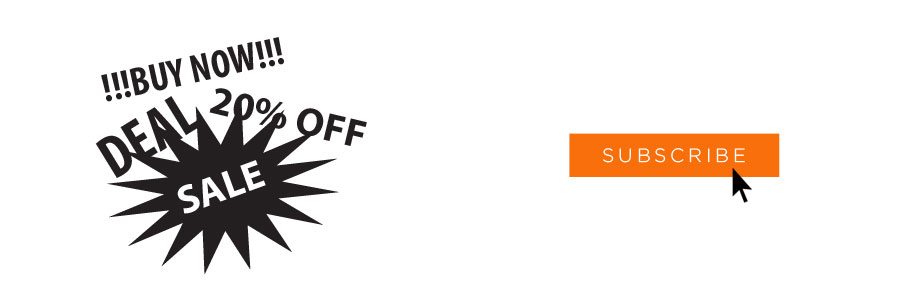
Outbound Marketing
Outbound marketing is interruption-based marketing.
Its premise is to find a medium with a large following and periodically interrupt them with disassociated ads. The hope is that, with some careful planning and a study of the demographics, a small percentage of the audience will listen to the interruption in the storyline and convert into a customer.
If you can find a large enough following or an above-average association, the small percentage of conversions will be worth the investment. Those opportunities are increasingly more like a needle in a haystack.
Outbound Marketing Examples: TV, radio, direct mail, newspapers, billboards.
Inbound Marketing
Inbound marketing is permission-based marketing. There are two premises here:
- First, communicate via mediums in which the audience has given you permission to communicate.
- Second, answer the questions people are asking and proliferate those answers around the web in anticipation of the question.
Both of these premises are permission-based.
In the first method, the audience is smaller in numbers than mass media. But because the audience has already raised their hand to get your messages, the audience coverts at a 750% higher rate than interruption-based marketing.
Inbound Marketing Examples: Subscription-based email marketing, social media, blog subscribers, webinar attendees, etc.
In the second method, the numbers are virtually limitless since your audience online is infinite. Thanks to keyword targeting, you can answer the questions prospects might be asking about your products and your industry. Since this audience is looking for the answers that you are proliferating throughout the web, the conversion rates are unparalleled.
Inbound Marketing Examples: SEO, keyword targeting, landing page strategy, content/blog strategy, etc.
An example of permission-based marketing that will put inbound into context is the Yellow Pages.
Before websites, subscription-based email, and blog subscriptions, the Yellow Pages was one of the few places you could advertise where prospects were actually looking for you and you weren’t interrupting them. The Yellow Pages was so successful that companies would name themselves AAA or ABC to be at the top of the listings.
In 2001, Vital had a $10,000 a month Yellow Pages marketing budget, buying enhanced listings and an ad in every book from Boston, MA, to Portland, ME. Why? Because it worked, and there was an incredible ROI.
2. Brand Positioning: Being a Footnote vs. Being the Main Story
Outbound Marketing
With outbound marketing, you are always a footnote. You’re forced to stick out or not be seen at all. It makes your relationship with your customer based on attention-grabbing rather than value.
If you are at a trade show, you can have the best booth with the best giveaway prize, but you are not the keynote speaker. When you are advertising during the Super Bowl, you can be the best commercial but the best commercial is merely a footnote to the main event.
At best, with outbound marketing you might strive to be the best footnote. Unfortunately, to stick out in traditional advertising you usually have to sacrifice your message for a gimmick and hope that some of the people who see the gimmick look closely enough for the footnote.
Inbound Marketing
With inbound marketing, you are the main story. You are the keynote speaker.
Inbound marketing is all about creating great content to share with your audience. It’s about telling stories and speaking to your audience where they want to be spoken to and how they want to be spoken to. It’s about delighting them, educating them, and engaging with them in an open and transparent way.
But inbound marketing is much more than simply being the keynote speaker at the trade show. It’s about being the article featured on the cover of the magazine. It’s about being the MVP at the Super Bowl.
And when done correctly, inbound marketing can open up these amazing distribution channels that make it so you don’t have to wait for the next trade show, the next magazine, or next year’s Super Bowl to show off your brand. You can do it on-demand with laser-like precision, penetrating a group of your peers and the influencers in your industry.
3. Marketing Strategies: Linear vs. Holistic
Outbound Marketing
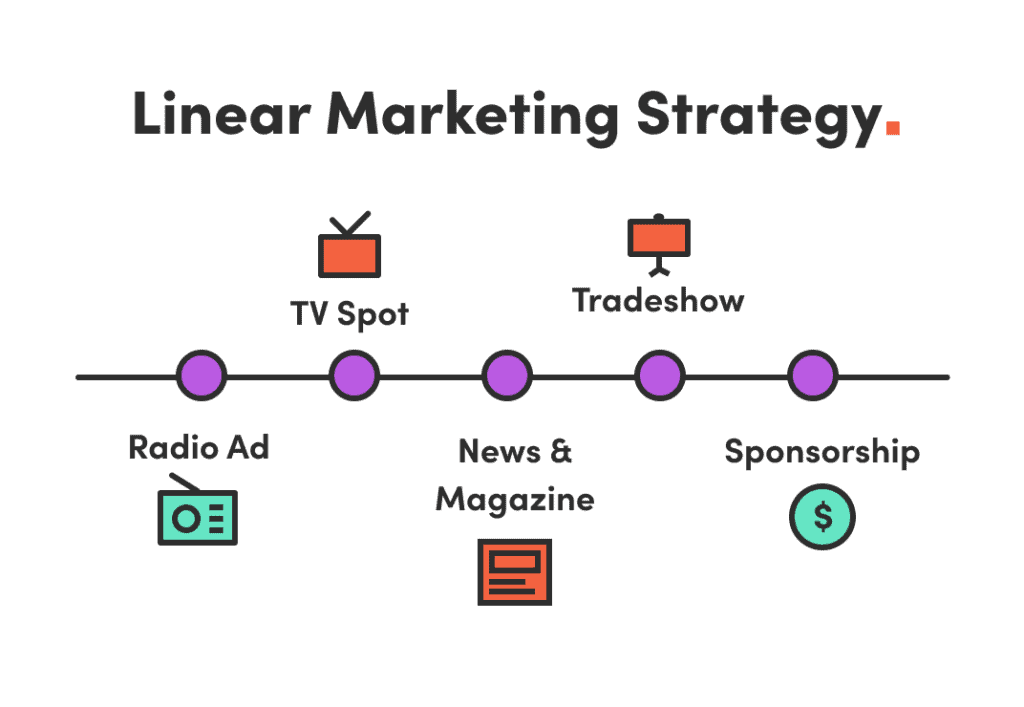
Outbound marketing strategies are very linear. You only have so many marketing avenues to choose from like radio, TV, direct mail, tradeshow, billboard, sponsorships, etc.
With this linear strategy, you assess which mediums most accurately address your target market and you start checking the boxes. You begin to attribute higher percentages of your budget to the more effective mediums and leave out the least effective mediums. You create a unified message across all mediums, and your job is done for the period.
Come back again next period, sift through the data, reassess the percentages, and do it again. Digital marketers can make the mistake of approaching the web with this outbound marketing approach. Social media, check! SEO, check! Email marketing, check!
Inbound Marketing
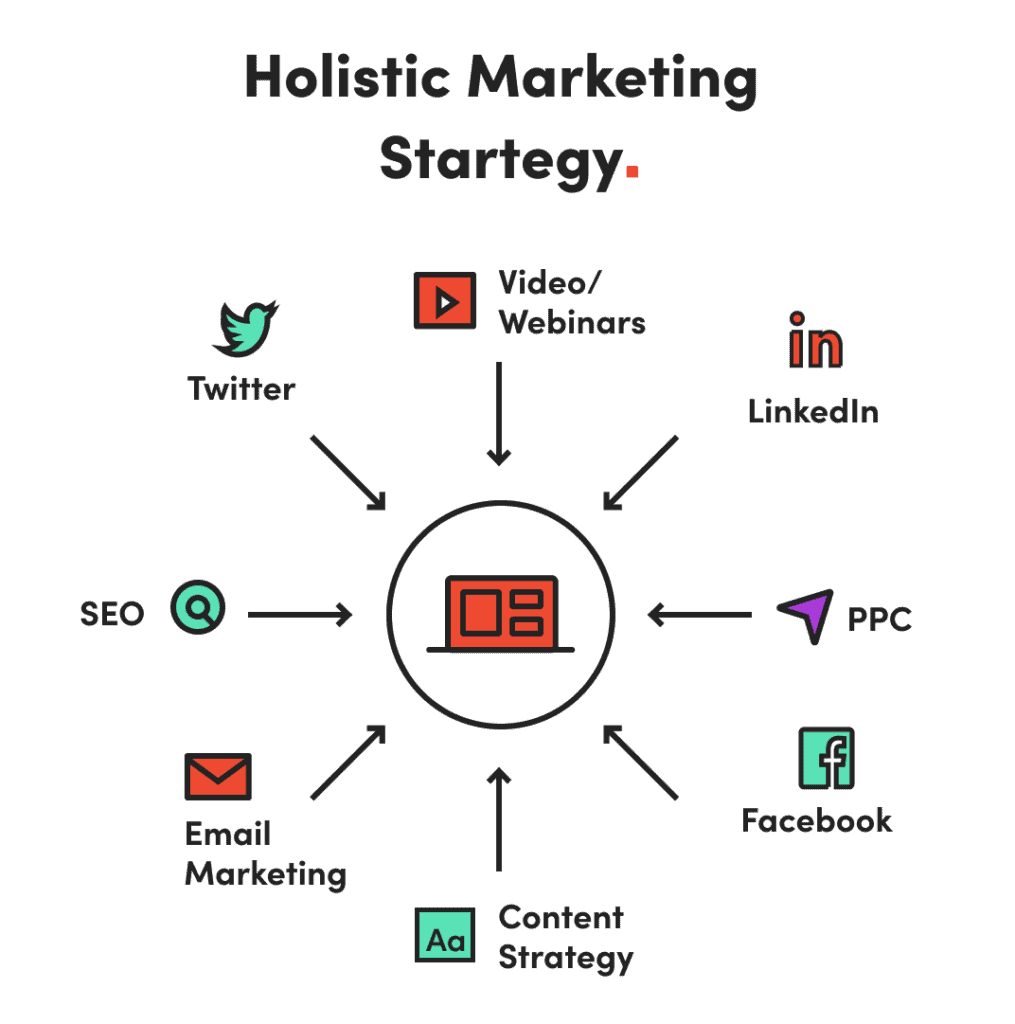
With inbound marketing, the strategy is holistic. It’s a more complex approach than outbound marketing, requiring:
- Simultaneous use of all digital channels.
- Continuous work to strengthen your website.
- Development of effective content.
- Implementation of measurement tools.
Many digital marketers don’t understand the complexities. They stick with the approach they are comfortable with — the outbound or linear approach applied to the digital world. This approach gets you the traditional results.
Inbound marketing is like a holistic lifestyle. In order to carry out a successful inbound marketing campaign, your website needs:
- A strong foundation.
- To be able to carry out strong messaging.
- A content marketing strategy.
- To be a hub for distribution.
- A blog.
- A responsive design.
- A call-to-action strategy.
- Micro and macro conversion opportunities.
- An easy-to-use content management system (CMS).
Once your website is in good shape, content creation and distribution can begin. Content needs to be engaging and meet the objectives of your keyword strategy. The distribution needs to tap into all avenues: RSS-fed email for blog subscribers, social media channels, lead nurture campaigns, etc.
But it is not within the linear check-box approach of outbound. Inbound requires daily attention with a constant analytical review. Like a holistic healthy lifestyle, it requires discipline and fortitude. Sometimes you need more content, sometimes you need more distribution. Sometimes you need more landing pages, sometimes more blog posts. Sometimes better conversion rate optimization, sometimes a stronger call-to-action strategy. But it always takes adjustment and strategy.
When a holistic inbound marketing strategy is hitting on all cylinders, your website is rock solid, your distribution is amplified, and your distribution channels are feeding the website a steady diet of visitors. Prospects are converted with the utmost optimization.
4. Messaging: Complicated vs. Educational
Outbound Marketing
With outbound marketing, the message is inherently “obfuscated, duplicitous and full of shit.” It has to be. With very little room to work with, whether it be in a newspaper ad or a few seconds on the radio, the goal of outbound marketing has always been to stand out.
In order to be a clutter buster, your relationship with the customer is compromised. Think about it: how else can we get someone to see your mortgage product in a quarter-page ad at the bottom of an article about coronavirus?
If you’re lucky enough to know where the ad will appear, you can try to force the message to fit the audience. But this rarely succeeds, and more often than not, you’re trying to message everyone ages zero to one hundred with the same message.
It’s all one big hoax, misdirection. It’s pulling that shiny quarter from behind your ear.
Inbound Marketing
With inbound marketing, the message is specific and useful. Rather than forced upon you, the message is instead offered up on a nice and shiny silver platter, ready for you to consume whenever convenient.
This message contains quality content that educates and engages. It’s meant to answer a consumer’s question, to fill in the blank.
Not long ago, marketing professionals would advise their clients to create deep discounts and BIG sales, and then advertise them to the masses. The thought process was that more consumers would then seek out the product and the increase in customers made up for the lost product value. The idea that I got paid to offer up that piece of bullshit advice is astonishing.
The reality today is that instead of advising our clients to slash prices or advertise on all mediums, we instead encourage them to offer something of even greater value: thought leadership. And if we have to offer discounts, we offer them to our loyal brand ambassadors as a reward for subscribing.
5. Distribution: Renting vs. Owning
Outbound Marketing
With outbound marketing, you’re always renting your distribution. As most advertisers know, you’re only as good as your last campaign or your last media buy. If it works and sales get a bump, it’s on to the next campaign. If it fails, then jobs and budgets are on the line.
With an outbound campaign like direct mail, the leads come in for a few weeks when the mail is hitting households. Once those leads are processed and the mail is distributed, you need to start again with a new message and a new distribution plan.
All marketers know there is only one good tradeshow a year; the rest are all washes. The Super Bowl only comes once a year, the World Cup eventually comes to an end, and the newspaper gets recycled the next day. Nothing in outbound marketing is iterative, and there are always costs associated with lead generation. This often makes for a negative ROI, finicky CEOs, and an overall high-pressure job.
Inbound Marketing
With inbound marketing, you own your distribution and it depreciates more like an asset. Here’s how:
- You build your subscription-based email list.
- You earn a top ranking on product-related keywords.
- You build a following on social media.
And voilà! You’re creating assets. There is a cost of acquisition (creating the content), but it is iterative and it keeps working for you long after you stop the acquisition/creation phase.
For the first time in a marketer’s career, we are creating value that will last beyond our tenure. Create a 20,000-person email list, acquire 50,000 social media fans, rank on the first page of Google for 400+ keywords with a total search volume of one million monthly searches, and you’ve created a Super Bowl opportunity every month of the year.
There are companies (HubSpot) literally lobbying our federal government to allow them to book inbound marketing as an asset instead of an expense. It makes a lot of sense. If you have 10,000 blog posts generating 1,500 leads per month through online searches and you stop posting for a year, that lead volume will likely only diminish slightly.
Over the years, you might see some fall off, but it is a lot more like depreciation of traditional assets. Needless to say, this is the type of marketing that makes CEOs happy and creates heroes out of the marketing department.
6. Data & Attribution: Immeasurable vs. Quantifiable

Outbound Marketing
With outbound marketing, success is hard to measure. We can ask our prospects how they heard of us, but in general, the results are unreliable. This creates a margin of error that is inherent within this archaic and linear model of marketing.
Sure, it’s great to hear that the company call center received a few dozen calls as a result of a targeted marketing effort. It’s also great when someone fills out the “How Did You Hear About Us?” form. But this doesn’t tell the whole story. The margin of error occurs when you assume you know the whole story, but assumptions lead to underperforming campaigns.
The measurement of outbound marketing lacks complexity and leads to a lack of results.
Inbound Marketing
With inbound marketing, everything is digital and everything is quantifiable. There’s no need to assume anything. Complex algorithms track if your marketing strategy is effective and if it is converting potential customers into full-blown clients.
An inbound marketing strategy is highly measurable. It allows for analysis of everything from the ROI of various distribution methods to whether the size and shape of a CTA button is more likely to attract a customer or not.
What I love most about inbound marketing is that it allows for closed-loop reporting, which means:
- It lets us track someone’s IP address from the second it hits our website.
- It tells us how that IP address got there and how much time it spent on the site.
- It provides an in-depth glimpse into the thought process of a consumer, showing which blog posts they read, which pages they viewed, whether they entered the site organically or through another avenue like social media, and lead generation metrics.
Again, inbound marketing is highly measurable.
Inbound marketing succeeds because it allows you to talk to people who have given you permission. You can tell your story in a holistic, educational way on your own distribution platform, with quantifiable metrics.
We know this to be true because we’ve experienced the shift, from our founding days in branding in 2001, through the rise of the digital marketing age and into this new era of inbound marketing.
Why is inbound marketing better than outbound marketing? It works. We’ve made it work for us and our clients. Talk to us to see how we can make it work for you.
